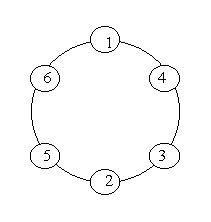Prime Ring Problem |
| Time Limit: 4000/2000 MS (Java/Others) Memory Limit: 65536/32768 K (Java/Others) |
| Total Submission(s): 644 Accepted Submission(s): 382 |
|
Problem Description
A ring is compose of n circles as shown in diagram. Put natural number 1, 2, ..., n into each circle separately, and the sum of numbers in two adjacent circles should be a prime.
Note: the number of first circle should always be 1.  |
|
Input
n (0 < n < 20).
|
|
Output
The output format is shown as sample below. Each row represents a series of circle numbers in the ring beginning from 1 clockwisely and anticlockwisely. The order of numbers must satisfy the above requirements. Print solutions in lexicographical order. You are to write a program that completes above process. Print a blank line after each case. |
|
Sample Input
6 8 |
|
Sample Output
Case 1: 1 4 3 2 5 6 1 6 5 2 3 4 Case 2: 1 2 3 8 5 6 7 4 1 2 5 8 3 4 7 6 1 4 7 6 5 8 3 2 1 6 7 4 3 8 5 2 |
|
Source
Asia 1996, Shanghai (Mainland China)
|
|
Recommend
JGShining
|
#include <cstdio> #include <cstring> #include <iostream> #include <string.h> using namespace std; #define N 50 int flag[N]; int prime[51]; int ok[50]; int vis[25]; int path[25]; int f=0; int n; void init() { memset(flag,0,sizeof(flag)); //全部置为0 int q = 0; //prime数组的下标 int i; for(i = 2;i * i < N;i++) { if(flag[i]) continue; //表示i为前面某个数的倍数,肯定不是素数 prime[q++] = i; for(int j = i * i;j < N;j += i) //将是i倍数的全部筛掉 { flag[j] = 1; } } for(i;i <= N;i++) //从i统计到N便是求得的2——N内的素数 { if(flag[i] == 0) prime[q++] = i; } for(i = 0;i < 15;i++) //打印前25个素数供你检查,就是100以内的那25个素数 { ok[prime[i]]=1; } } void print(int i) { if(f==0) { printf("%d",i); f=1; } else { printf(" %d",i); } if(path[i]==i) return; print(path[i]); } void dfs(int x,int s) { if(s==1&&ok[x+1]) { f=0; print(1); printf(" "); return; } for(int i=2;i<=n;i++) { if(vis[i]) continue; if(ok[i+x]) { path[x]=i; vis[i]=1; dfs(i,s-1); vis[i]=0; path[i]=i; } } return; } int main() { memset(vis,0,sizeof (vis)); memset(ok,0,sizeof (ok)); init(); for(int i=0;i<=20;i++) path[i]=i; int c=1; while(scanf("%d",&n)!=EOF) { printf("Case %d: ",c++); dfs(1,n); printf(" "); } return 0; }